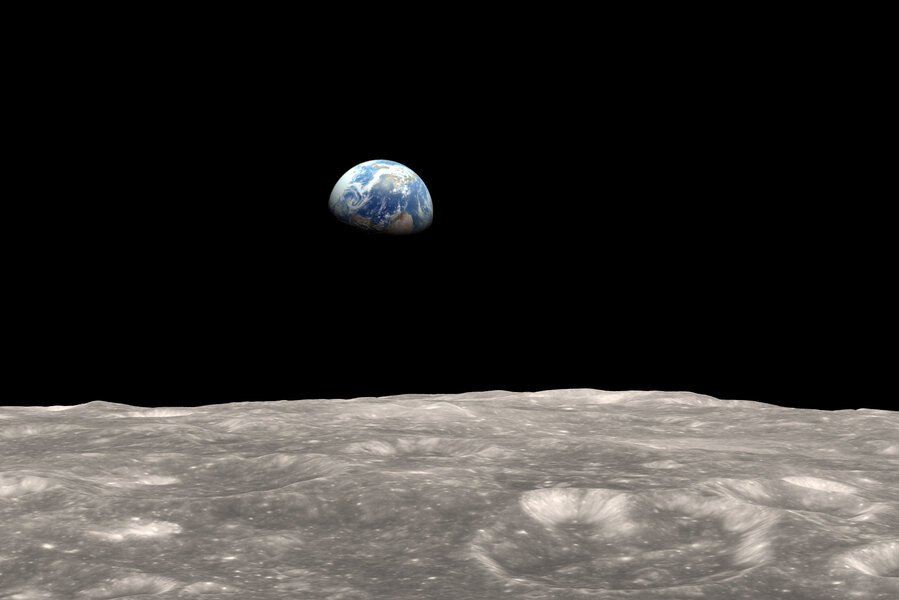NASA scientists measure the moon's dancing tides
Loading...
And one-two-three and one-two-three... Earth and the moon are whirling around the sun like dancing partners. Earth leads, while the smaller and lighter moon follows gracefully. Like the best dancing partners, Earth and the moon are attracted to each other – in this case, gravitationally. The tug between the two bodies stretches them both, causing many interesting effects, including the rising and falling tides of Earth's oceans.
The pull goes both ways, and since the moon doesn't have oceans, the rocky lunar surface must bend and flex in response to Earth's tug. In fact, neither the Earth nor the moon is a perfect sphere (nor even a perfectly oblate spheroid): both are a bit egg-shaped, with their ever-so-slightly pointy ends facing each other.
How big are these tides? It's easy enough to measure ocean tides here on Earth, but watching the lunar tide come in is a bit more complicated.
“The deformation of the moon due to Earth’s pull is very challenging to measure, but learning more about it gives us clues about the interior of the moon,” said Erwan Mazarico, a scientist with the Massachusetts Institute of Technology in Cambridge, Mass., in a press release.
To measure this very small tide – less than two feet high – a team of scientists performed some very clever analyses using data from two NASA orbiters.
They started with data from the Lunar Orbiter Laser Altimeter (LOLA), riding on board NASA's Lunar Reconnaissance Orbiter. LOLA mapped the moon's surface by pinging lasers down to the surface and counting how long it took for the beams to bounce back up. The longer the travel time, the further away that part of the surface was. By combining more than 5 billion measurements gathered over 3 years, scientists created a map of the surface.
That was step one.
Step two was looking at the places where two orbits by LRO crossed over each other, that is, the spots that the spacecraft passed over multiple times.
“If nothing changed on the moon – if there were no lunar body tide or if its tide were completely static – then every time scientists measured the surface height at a particular location, they would get the same value,” said Mike Barker, a Sigma Space Corporation scientist based at Goddard and co-author of the new study, which is available online in Geophysical Research Letters.
But these crossed paths didn't always record the same distance, and the reason wasn't always the tidal bulge. In fact, the tidal bulge was downright small compared to other forces affecting the altimetry data – a bit like looking for a pea underneath a stack of mattresses.
LRO tried to fly perfectly level, 30 miles (50 km) above the moon's surface, but the little spacecraft couldn't keep from dipping and rising in response to the moon's lumpy gravity field. Places with a lot of magma or other dense rock would pull LRO closer, while lower-gravity places would let LRO fly higher. Fortunately, NASA has recently devoted a mission to mapping the lumps and bumps of the moon's gravity.
That was step three – using data from NASA’s Gravity Recovery and Interior Laboratory mission (GRAIL) to correct for the lunar gravity field.
"The extraction of the tide from the LOLA data would have been impossible without the gravity model of the moon provided by the GRAIL mission,” said David Smith, the principal investigator for LRO’s LOLA instrument and the deputy principal investigator for the GRAIL mission.
Step four was removing any measurements taken during the lunar night, since the temperature change from day to night altered the effectiveness of the altimeter.
After they had pared away effects of gravity, and looked only at crossovers between daytime paths, they ended up with 9902 orbits that crisscrossed nearly 500,000 times. They then removed measurements taken on steep slopes (>20 degrees) or that were otherwise ambiguous, and ended up with 354,840 usable crossover points, scattered across the near and far sides of the moon.
When they looked at measurements taken at the same spot, they watched whether the height had risen or fallen from one satellite pass to the next, and successfully teased out the changing shape of that tiny bulge. Most surprisingly, they found that the tidal bulge moves over time.
Although the same side of the moon constantly faces Earth, the shape and tilt of the moon's orbit mean that, from the moon’s perspective, Earth doesn't sit motionless but moves around within a small patch of sky. Like any good dance partner, the bulge follows Earth’s movements – precisely.
The new results for the size of the bulge and calculation of the moon's overall stiffness (known as the Love number h2 ) were similar to results calculated during other missions, but the new numbers are much more precise than before.
“This research shows the power of bringing together the capabilities of two missions," said Dr. Smith.






